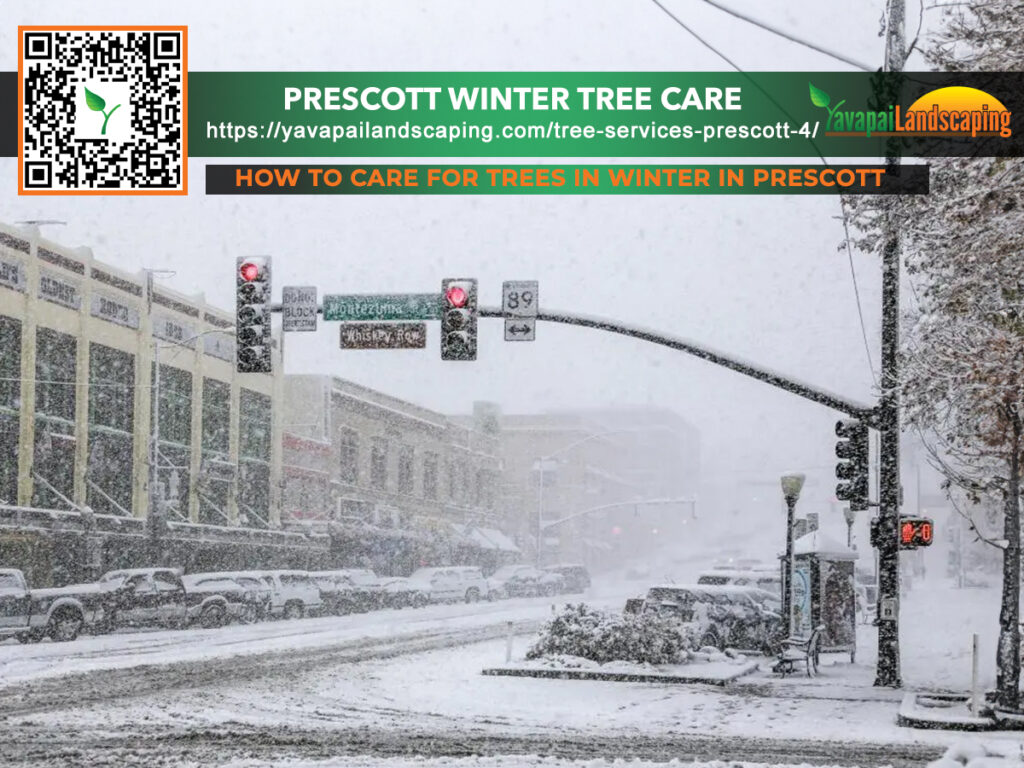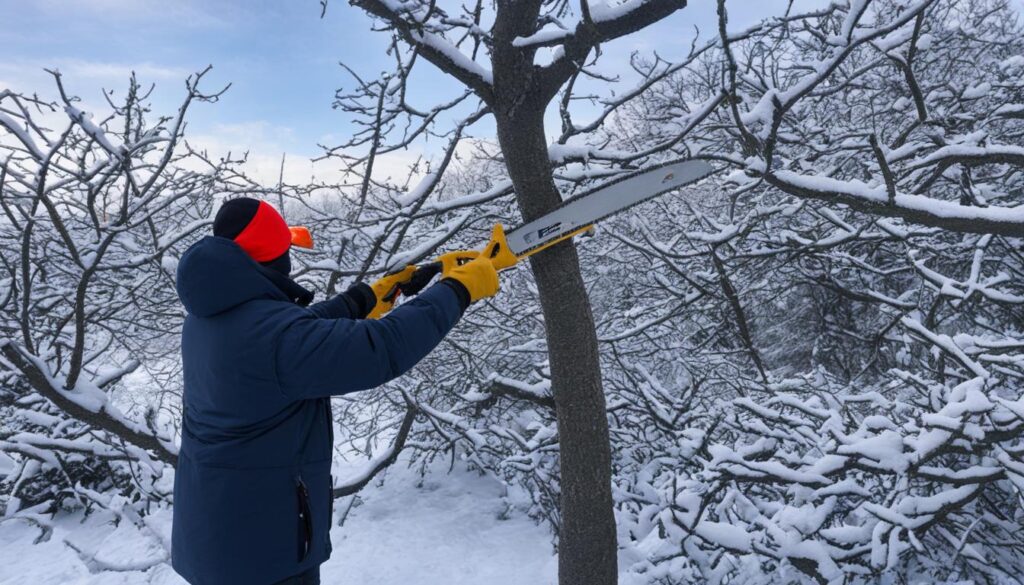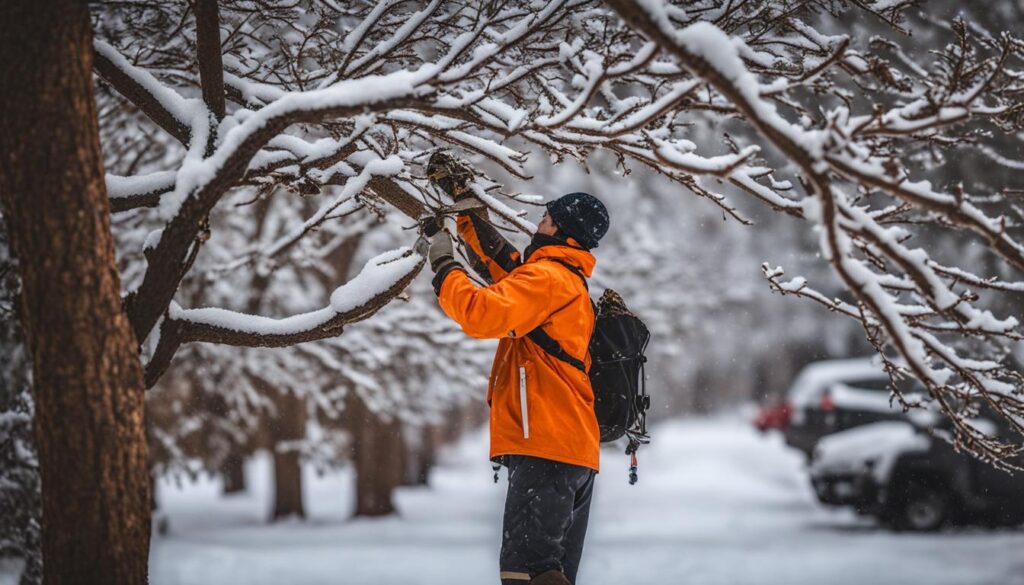
As a homeowner in Prescott, AZ, it is essential to understand the importance of winter tree care. It ensures the health and longevity of your garden, and it is vital to take precautions and adopt best practices to keep your trees in good condition during the cold season.
Winter tree care involves various techniques, such as pruning, protecting trees from winter elements, assessing tree health, and proper watering. In this winter tree care guide, we will cover these techniques and provide you with the necessary tips to safely care for your trees during winter.
Key Takeaways
- Winter tree care is crucial for the health and longevity of your garden.
- Assessing tree health before winter is important to identify potential issues.
- Proper pruning techniques and timing can promote tree strength and reduce the risk of winter damage.
- Protecting trees from harsh winter elements with mulching and wrapping can safeguard them from cold, wind, and frost.
- Proper watering during winter is essential in maintaining tree health.
Understanding the Importance of Winter Tree Care
If you want to keep your trees healthy all year round, it’s crucial to take care of them during the winter season as trees are highly vulnerable at this time. Winter tree care precautions are essential to ensure that your trees can withstand the harsh winter weather and emerge healthy in the spring. By taking the right winter tree care measures, you can prevent damage to your garden and safeguard your property from potential risks.
There are specific winter tree care techniques that you can use to keep your trees healthy during this season. These techniques involve monitoring your trees’ conditions, identifying potential problems that can arise during winter, and applying the necessary precautions to mitigate these issues.

Tree Care During Winter
Winter tree care involves taking steps to protect the trees in your garden from harsh winter elements, such as wind, snow, and frost. One common tree care technique is to provide adequate moisture to the roots through proper watering. This technique ensures that the trees have the necessary hydration that they need to stay healthy and robust during the winter season.
It’s also essential to prune your trees before winter arrives, as this will promote better tree strength and reduce the risk of winter damage. When pruning, focus on removing any dead or damaged branches that may not withstand the weight of snow or ice.
Winter Tree Care Precautions
It’s important to take certain precautions when dealing with winter tree care. For example, homeowners should avoid making drastic changes to the garden’s soil or fertilizing the trees during this season, as this can lead to stronger growth, but immature plants cannot handle the increased root pressure. Furthermore, wrapping trees with burlap or other materials can be dangerous to the tree’s health, as moisture and pests can get trapped inside, creating an environment conducive to disease.
When caring for trees during winter, homeowners need to use best practices for winter tree care, such as monitoring the trees’ health and taking corrective measures promptly. By taking the necessary measures and working with an arborist, you can help ensure that your trees remain healthy all year round, even during harsh winter conditions.
Assessing Tree Health Before Winter
Before winter begins, it’s essential to assess your trees’ health to determine their ability to withstand the cold season. Here are some key indicators to keep in mind:
- Foliage condition: Check whether the leaves are green and healthy-looking or wilted and brown. This can indicate whether the tree is receiving adequate water and nutrients.
- Branch stability: Inspect the branches to ensure they’re solidly attached to the trunk and not likely to break under the weight of snow or ice.
- Signs of disease or infection: Look for any discoloration, fungus growth, or other signs of illness that could indicate the need for treatment before winter.
If you notice any concerns with your trees’ health before winter, it’s crucial to address them promptly. Consult with a professional arborist if you have any questions or concerns about your trees’ health.
Pruning Trees for Winter Readiness
Proper pruning techniques are important for winter tree care. Pruning helps to promote tree strength and reduces the risk of winter damage such as broken branches or limbs. Timing is also important. It is best to prune before winter sets in to avoid shocking the trees and to promote optimal healing.
Winter tree care techniques:
- Prune trees to remove any dead, dying, or diseased branches or limbs.
- Make clean cuts with sharp tools to avoid damaging the tree bark.
- Do not prune more than one-third of the tree’s canopy.
- Consider hiring a professional arborist for larger or more complex pruning jobs.
To ensure your pruning efforts are successful, we recommend consulting a reputable tree care guide or seeking advice from a local horticulturist.
When is the Best Time to Prune for Winter?
| Tree Type | Best Pruning Time |
|---|---|
| Deciduous trees | Late winter, before new growth emerges in spring |
| Conifer trees | Early fall or late spring |
| Fruit trees | In late winter or early spring before buds start to break |
Pruning before winter can help keep your trees healthy, strong, and ready to face the challenges of the season. Follow these winter tree care tips to keep your trees thriving through the coldest months of the year. Educate yourself on How Emergency Winter Tree Services Handle Critical Limb Removal.
Protecting Trees from Winter Elements
Winter can be brutal on trees, but there are many things you can do to help protect them from the harsh weather. Follow these best practices for safe winter tree care and winter tree care precautions:
Mulching
Mulching is one of the simplest and most effective ways to protect trees in winter. A thick layer of mulch around the base of the tree can help insulate the roots and prevent them from freezing. It also helps retain moisture and suppress weeds. Use organic mulch like chipped bark, wood chips, or leaves, and apply it in a circle about 3ft wide around the base of the tree, making sure not to pile it against the trunk.
Wrapping
For young or thin-barked trees, wrapping the trunk can help prevent cracking or splitting caused by temperature fluctuations. Use tree wrap or burlap to wrap the trunk up to the first branches. Be sure to remove the wrapping in the spring to prevent moisture buildup and potential disease or insect infestation.
Using Tree Guards
Tree guards are an effective way to protect trees from wind and frost damage. These guard structures are made of various materials such as plastic, metal, or fabric and can be placed around the tree, creating a protective layer. Be sure to remove them when the weather warms up to avoid trapped moisture and pest buildup.

These winter tree care tips and best practices for winter tree care can help ensure healthy and safe trees throughout the winter season. Stay vigilant and protect your trees from winter elements and hazards to keep them thriving for years to come.
Watering Trees in Winter
Watering your trees in winter is crucial to their health and survival. While trees generally require less water during the cold season, it’s essential to provide them with enough moisture to prevent drying out.
The key is striking a balance between giving your trees enough water and avoiding overwatering. Overwatering can lead to root rot, which may damage or kill your trees.
Here are some tips for watering your trees in winter:
- Check the soil moisture regularly. If the soil is dry to the touch, your trees need water.
- Water your trees during the warmest part of the day when the soil is not frozen.
- Apply water to the base of the tree. Avoid spraying the foliage.
- Use a soaker hose or drip irrigation system to ensure that water is applied slowly and evenly.
- Reduce watering frequency during rainy or snowy periods.
Proper watering is just one of the many important aspects of winter tree care. Continue reading to learn more about tree care during winter.
Dealing with Winter Pests and Diseases
As a homeowner, you understand the importance of maintaining the health of your trees during the winter season. However, despite your best efforts, pests and diseases can still pose a significant threat to your trees. This section will discuss how to identify and address common winter pests and diseases.
One of the most common winter tree pests is the bark beetle. These small insects can attack weakened or stressed trees and cause significant damage. To prevent bark beetle infestations, ensure your trees are well-maintained and healthy. If you notice any signs of bark beetle activity, such as small holes or sawdust around the tree’s base, contact a professional tree care service for assistance.
Another potential threat to your trees during the winter is frost damage. Frost damage can occur when temperatures drop suddenly, causing the water in the tree’s cells to freeze and burst. To prevent frost damage, avoid pruning your trees in late summer or fall, as this can stimulate new growth that is susceptible to frost damage. Also, be sure to wrap your trees in burlap or other protective material to shield them from freezing temperatures and strong winds.
In addition to pests and frost damage, trees can also develop diseases during the winter season. One common disease is called ‘winter injury,’ which is caused by sudden temperature changes and can cause the bark and branches to crack or split. To prevent winter injury, avoid using deicing salts near your trees and provide them with adequate moisture throughout the winter season.
If you notice any signs of pest infestations or disease in your trees, it’s important to act quickly and seek the help of a professional tree care service. They can identify the problem and develop a customized treatment plan to restore your tree’s health and protect it from future damage.
Yavapai Landscaping Prescott offers free quotations for Prescott and its nearby localities for landscaping and tree services. These include tree removal, trimming, stump grinding, land clearance, storm clean up, and emergency tree service
